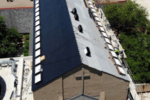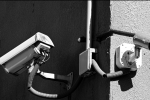November 2002
Buildings and Grounds
Hospitality Matters: Seeing Our Buildings Anew
If we believe that hospitality is a Gospel mandate, it is part of the mission of the church to look at our buildings with fresh eyes, to take an inventory, and to take care of the things that need attention. In terms of facilities, hospitality translates into four categories: safety, accessibility, comfort and attractiveness. Let’s look from the outside in, with Sunday morning as the focus.
The Approach
- Is the church pleasing to look at? Besides general maintenance, does the landscaping enhance the building or hide it? Does shrubbery encroach on entry walkways, signs, exterior lighting or windows? Attention to detail and bright plantings near the entry draws attention to it, and to the changing church seasons.
- Are walkways and entries clear and easy to negotiate? Or have roots, settlement or frost heaves created broken slabs and safety hazards? In facility triage, safety needs have highest priority. If they can’t be fixed immediately, slippery walkways and steps should be highlighted with tape, paint or non-skid coatings.
- Is it clear where to park? While spaces for the disabled are mandated by law, not all churches remember to mark a few convenient parking spaces "reserved for visitors."
- Are signs clear and well-coordinated? Or is the church sign that was so nice twenty years ago in need of replacement or new paint? Can new parents find the nursery? Are restrooms and offices clearly marked?
- How hard is it to enter by a wheelchair, crutches, or a stroller? It’s not enough to provide access if it can’t be found, or if you need assistance to negotiate it.
- Visitors should be able to see inside the building as they approach. At the very least, a pair of wide-open doors into a well-lit entry helps.
- The entry area or narthex needs to be attractive and constantly monitored to keep clutter down. Does the visual serenity of your entry enhance a sense of calm and reverence? Or is it the repository of lost umbrellas, galoshes, hats and coats, dusty hymnals, errant crayons, out of date postings, dying plants, and boxes? Be ruthless.
- Post things elsewhere. Leave space for the visitors’ book, bulletins for one service only, copies of the church newsletter, and large-print prayer books and hymnals.
- Can everyone see clearly? Quality lighting can really "pop out" a handsome old building. New lighting may also be more energy-efficient. A good lighting consultant is well worth the expense. It is not always necessary to replace old fixtures - it may be possible to augment the system and relamp instead.
- Does the seating work for everyone? Is space allowed for wheelchairs? Do little people have to peer over pews? Some churches have made the front row of seating into kid-friendly soft cushions on the floor. If seating is so uncomfortable as to be a hindrance to worship, consider replacement.
- How are the acoustics? Bad acoustics discourage people from singing. Sound does not turn corners. An acoustical consultant can help find solutions, including more resonant surfaces, baffles, and sensitive amplification.
- Is the floor covering dangerously worn? Torn, frayed or bunched carpets are a safety hazard. Old softwood pews can splinter – repair them.
- People with chemical and environmental sensitivities are miserable in buildings where there is perfume, incense, or poor ventilation. Some churches ask parishioners not to wear scent. If incense is used for a special service, can the sanctuary be fully opened and ventilated in time for the next event?
- As in the entry, strive to minimize visual clutter. One cross is enough – more diminish the primacy of the symbol. Think hard about how much "stuff" you need. Less is more.
- Is your color scheme stuck in a ‘60s beige syndrome? Paint and finishes can be brought up to date, brightened, and made richer for a comparatively moderate outlay.
In short, church is like home. When it is warm, inviting and safe, we all feel better. When company is coming, you want them to feel neither intimidated nor discouraged, but at home. And at church, company is always coming. The welcome our buildings extend should mirror God’s love. Our church facilities should be places from which we go to do the things the Gospel asks us to do. Is this too big a charge? Maybe that’s okay. Keep the larger goal in mind, and a task list that may seem daunting starts to look more like an opportunity for faithful, even joyful ministry. After all, the church is God’s house. Can we do any less?
The Rev. Eliza Linley is a priest, architect and liturgical artist in Berkeley, California. She is chair of the Architecture Commission of the Diocese of California and serves on the board of the Episcopal Church Building Fund.






